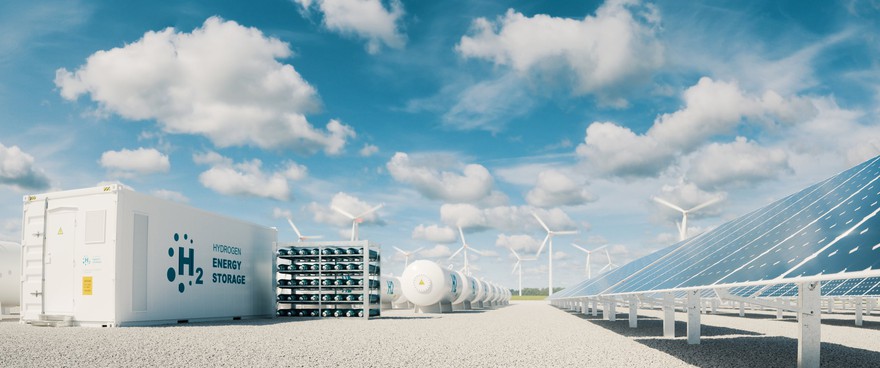Hydrogen stocks are publicly traded companies seeking to capitalize on the enormous potential of hydrogen. This energy source emits no greenhouse gases when burned. The only waste product is water vapor, making it a cleaner energy source than fossil fuels such as natural gas, oil, and coal. These features make it a potential future source of lower-carbon energy.

The drawback of hydrogen as a fuel source is that it's rarely found in an easily extractable form. Although hydrogen can be produced from a variety of sources, most methods emit greenhouse gases, and clean hydrogen has not yet been produced at the scale needed to be economically competitive with fossil fuels.
However, that could change in the coming years. Several companies are working hard to tap into the enormous promise of this potentially emission-free fuel.
What to know about investing in hydrogen
There are a few things investors should know about the hydrogen industry before investing in the sector, including:
- Types of hydrogen: There are several ways to produce hydrogen, some of which produce carbon dioxide as a byproduct. The industry refers to hydrogen produced from burning natural gas as "blue hydrogen," which requires carbon capture and storage (CCS) to isolate greenhouse gas emissions. "Green hydrogen," produced by renewable energy to power an electrolyzer that splits hydrogen from water molecules, doesn't emit any greenhouse gases. Green and blue are two of the many colors used to classify hydrogen by its production method and emissions profile.
Carbon Credits
- Similar to batteries: Hydrogen fuel cells work much like batteries, generating electricity through an electrochemical reaction. However, hydrogen fuel cells are refueled with more hydrogen rather than being recharged like a traditional battery.
- Multiple current uses: Hydrogen fuel cells already have many uses. They're found in many motorized vehicles (e.g., cars, trains, buses, maritime vessels, and trucks) and also serve as a stationary power source.
- Massive market opportunity: Hydrogen has vast potential as a replacement fuel. It could one day replace natural gas in the pipeline system to generate electricity at power plants and as a fuel source for our homes. Due to its potential, some forecasts peg the future value of the clean hydrogen market as high as $11 trillion.
- Costs: Although clean hydrogen holds great promise as a potential emissions-free fuel source, it's costly to produce. It costs as little as $1.50 per kilogram to produce hydrogen from natural gas and between $3 and $12 per kilogram to produce clean hydrogen. The U.S. Department of Energy wants to reduce the cost of clean hydrogen to $1 per kilogram over the next decade to make it a more competitive fuel source.
Best hydrogen stocks to buy in 2025
Given the potential of clean hydrogen, a growing number of companies are investing in the sector. Many energy and industrial companies are in the early stages of exploring the possibility of hydrogen energy.
However, a handful of companies are already emerging as early leaders in the sector. Here are seven leading hydrogen companies to keep an eye on as the industry matures.
| Name and ticker | Market cap | Dividend yield | Industry |
|---|---|---|---|
| Linde (NASDAQ:LIN) | $191.1 billion | 1.81% | Chemicals |
| Bloom Energy (NYSE:BE) | $24.2 billion | 0.00% | Electrical Equipment |
| Plug Power (NASDAQ:PLUG) | $3.1 billion | 0.00% | Electrical Equipment |
| BP (NYSE:BP) | $95.2 billion | 5.26% | Oil, Gas and Consumable Fuels |
| Air Products And Chemicals (NYSE:APD) | $58.0 billion | 2.74% | Chemicals |
| Cummins (NYSE:CMI) | $70.1 billion | 1.50% | Machinery |
| FuelCell Energy (NASDAQ:FCEL) | $231.9 million | 0.00% | Electrical Equipment |
1. Air Products
Air Products (APD +0.49%) is a global leader in supplying industrial gases and liquefied natural gas (LNG) processing technology and equipment. It's also one of the world's largest suppliers of merchant hydrogen and a leader in hydrogen fuel infrastructure. It has more than 100 hydrogen plants with the capacity to produce 7 million kilograms of fuel each day.

NYSE: APD
Key Data Points
Air Products aspires to be a leader in providing solutions to the world's energy and environmental challenges through gasification, carbon capture, and clean hydrogen. It has several major hydrogen projects underway that it expects to complete in the coming years.
For example, it has completed 80% of the construction of its NEOM Green Hydrogen Project in Saudi Arabia, which should begin production by 2027. It's also working on a potential $8 billion blue hydrogen project in Louisiana and a $3.3 billion blue hydrogen project in Canada, as well as a smaller $360 million green hydrogen project in Arizona that could come online in 2026.
2. BP
BP (BP -0.15%) is a global oil and gas producer with grand lower-carbon energy ambitions. It set a goal to be a net-zero company by 2050 or earlier, and hydrogen is an aspect of its strategy. BP intends to grow its hydrogen business by investing in five to seven hydrogen and CCS projects worldwide.

NYSE: BP
Key Data Points

NASDAQ: PLUG
Key Data Points
It's one of the world's largest hydrogen buyers and operates a leading hydrogen refueling network in North America with more than 275 fueling stations. Plug Power is building an end-to-end green hydrogen network to produce, store, and deliver the fuel across North America and Europe.
In late October 2025, Plug Power expanded its partnership with Allied Biofuels in Uzbekistan to deploy as much as 2 gigawatts (GW) of its GenEcon electrolyzers. That deal builds on a 3 GW agreement in Australia.

NYSE: BE
Key Data Points

NASDAQ: LIN
Key Data Points

NYSE: CMI
Key Data Points
In October 2025, Cummins secured a deal to test one of its prototype hydrogen-powered internal combustion engines in a model intercity bus made by Turkish-Japanese auto company Anadolu Isuzu. This engine performs as well as a natural gas engine with significantly lower emissions.
7. FuelCell Energy
FuelCell Energy is a global leader in delivering distributed baseload energy (energy produced on-site to provide steady power to a building). The company's proprietary fuel cell technology features carbonate fuel cells (those powered by natural gas and biofuels) and hydrogen fuel cells. The company also makes carbon recovery and carbon capture systems.

NASDAQ: FCEL
Key Data Points
The company is working on advancing a large-scale hydrogen production system using its proprietary solid oxide electrolyzer cell. These modular systems could provide baseload power to large-scale manufacturing plants and data centers.
Benefits and risks of investing in hydrogen stocks
Investing in hydrogen stocks has its share of pros and cons. Some benefits of investing in hydrogen stocks include:
- Growth potential: Hydrogen has the potential to grow into a multitrillion-dollar global market in the coming decades, which could fuel strong gains for top hydrogen stocks.
- Cleaner: Hydrogen (green hydrogen and blue hydrogen paired with CCS) is a cleaner fuel source compared to oil and natural gas, so investing in the sector can help support the environment.
On the other hand, some risks of investing in hydrogen stocks include:
- Market challenges: The hydrogen market can be very challenging due to the volatility of hydrogen prices and changing government policies. These and other issues have caused some hydrogen companies to cancel major expansion projects.
- Higher risk companies: Many hydrogen companies have higher risk profiles due to their weaker balance sheets and lack of profitability.
How to invest in hydrogen stocks
Anyone can invest in hydrogen stocks. Here's a step-by-step guide on how to add one to your portfolio:
- Open your brokerage app: Log in to your brokerage account where you handle your investments.
- Search for the stock: Enter the ticker or company name into the search bar to bring up the stock's trading page.
- Decide how many shares to buy: Consider your investment goals and how much of your portfolio you want to allocate to this stock.
- Select order type: Choose between a market order to buy at the current price or a limit order to specify the maximum price you're willing to pay.
- Submit your order: Confirm the details and submit your buy order.
- Review your purchase: Check your portfolio to ensure your order was filled as expected and adjust your investment strategy accordingly.
Related investing topics
Investment considerations for hydrogen stocks
Hydrogen energy has enormous potential. The emissions-free fuel could help decarbonize heavy industry, replace natural gas, and store renewable energy, paving the way for a truly net-zero world. It represents a multitrillion-dollar market opportunity.
However, hydrogen is still developing as a commercially viable fuel source. The industry needs to scale up and reduce costs to become competitive with fossil fuels and other emerging technologies, such as battery storage. The industry also relies on government support in the form of loan guarantees and other tax incentives, which can change based on the outcome of elections.
Given these factors, investors should evaluate whether they can handle the risks associated with investing in hydrogen stocks. Many pure-play hydrogen companies are unprofitable, making them riskier. Meanwhile, other larger companies involved in the sector make most of their money elsewhere.
As a result, investors might want to watch the sector from the sidelines and wait for the sector to develop. Alternatively, you can consider investing in hydrogen by taking a basket approach (buying several different hydrogen stocks with varying risk profiles) or through a hydrogen ETF.









